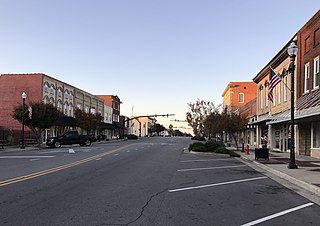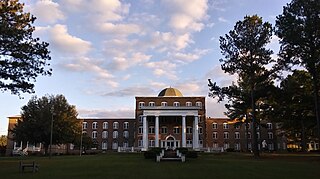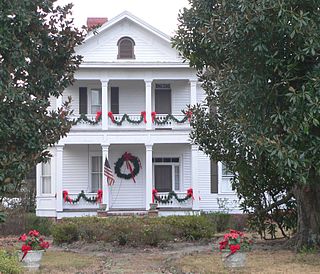
Robeson County is a county in the southern part of the U.S. state of North Carolina and is its largest county by land area. Its county seat and largest community is Lumberton. The county was formed in 1787 from part of Bladen County and named in honor of Thomas Robeson, a colonel who had led Patriot forces in the area during the Revolutionary War. As of the 2020 census, the county's population was 116,530. It is a majority-minority county; its residents are approximately 38 percent Native American, 22 percent white, 22 percent black, and 10 percent Hispanic. It is included in the Fayetteville-Lumberton-Pinehurst, NC Combined Statistical Area. The state-recognized Lumbee Tribe of North Carolina is headquartered in Pembroke.

Tar Heel is a town located in Bladen County, North Carolina, United States. As of the 2010 census, the town population was 117.

Raeford is a city in Hoke County, North Carolina, United States. Its population was 4,611 at the 2010 census, and in 2018, the estimated population was 4,962. It is the county seat of Hoke County.

Lumberton is a city in Robeson County, North Carolina, United States. As of 2020, its population was 19,025. It is the seat of Robeson County's government.

St. Pauls is a town in Robeson County, North Carolina, United States. The population was 2,035 at the 2010 census.
Caldwell House may refer to:

The Lumber River, sometimes referred to as the Lumbee River, is a 133-mile-long (214 km) river in south-central North Carolina in the flat Coastal Plain. European settlers first called the river Drowning Creek, which is still used as the name of its headwater. The waterway known as the Lumber River extends downstream from the Scotland County-Hoke County border to the North Carolina-South Carolina border. Soon after crossing into South Carolina, the Lumber River flows into the Little Pee Dee River, which flows into the Pee Dee River, or Great Pee Dee River. Finally, the combined waters flow into Winyah Bay and the Atlantic Ocean.

Flora MacDonald College was a women's college in Red Springs, Robeson County, North Carolina. It was founded in 1896 by Dr. Charles Graves Vardell as the Red Springs Seminary, renamed Southern Presbyterian College and Conservatory of Music in 1903 then Flora MacDonald College in 1914.

This list includes properties and districts listed on the National Register of Historic Places in Robeson County, North Carolina. Click the "Map of all coordinates" link to the right to view a Google map of all properties and districts with latitude and longitude coordinates in the table below.
The Humphrey–Williams Plantation is a historic plantation complex located near Lumberton, Robeson County, North Carolina. The Humphrey–Williams House was built about 1846 with the forced labor of enslaved people, and is a two-story, five-bay, vernacular Greek Revival style frame farmhouse. It features a one-story, full-width shed porch. Also on the property are the contributing William Humphrey House, Annie Fairly's House, tobacco barn, a carriage house, a smokehouse, a store-post office (1835-1856), and the agricultural landscape.
Gaston Layton Pridgen, known as G. L. Pridgen, is a former Republican member of the North Carolina House of Representatives. In the House of Representatives, he represented the 46th District, including constituents in Hoke, Robeson, and Scotland counties from 2011 to 2013. A retired telecommunications technician from Lumberton, North Carolina Pridgen also has experience in the United States Military.

William Laurence Saunders (1835–1891) was an American attorney, newspaper editor, historian, Ku Klux Klan chief organizer in North Carolina, and the North Carolina Secretary of State from 1879 until his death in 1891.

Luther Henry Caldwell House is a historic home located at Lumberton, Robeson County, North Carolina. It was built between 1893 and 1903, and is a large two-story, eclectic Queen Anne style frame dwelling. It features a double tier wraparound porch with an octagonal pavilion and decorative woodwork on the porches, bayed gable end projections, and gable fronts. It was the home of Luther Henry Caldwell, an important business and social leader in Lumberton.

Alfred Rowland House, also known as Riverwood, is a historic home located at Lumberton, Robeson County, North Carolina. It was built between 1875 and 1880, and is a two-story, cross-gable, side-hall plan, transitional Italianate / Greek Revival style frame dwelling. The front facade features an engaged, double-tier, pedimented porch.

Baker Sanatorium is a historic sanatorium in Lumberton, Robeson County, North Carolina. It was built in 1920–1921, and is a 3+1⁄2-story, five-bay, T-shaped Mission Revival style brick building. The building features an arcaded porch, and the roofs are sheathed in terra cotta mission tiles. The hospital continued in operation until 1993. It has been converted to apartments.

Carolina Theatre, also known as the Carolina Civic Center, is a historic movie theater located at Lumberton, Robeson County, North Carolina. It was built in 1927–1928, and is a three-story, Italian Renaissance style brick and terra cotta building. The theatre closed in 1975 amid a general exodus of businesses from downtown Lumberton. Plans were made to demolish it and build a parking lot, but community activists lobbied to have the building spared. It was reopened as the Carolina Civic Center in 1985 and underwent renovations in 2008.

Planters Building, also known as the First Union Bank Building, is a historic office building located at Lumberton, Robeson County, North Carolina. It was designed by the firm of Wilson, Berryman & Kennedy and built in 1925–1926. It is a five-story, Classical Revival style steel frame building sheathed in brick and rusticated cast concrete. The ground levels feature round arched windows and the main entrance is reached through a barrel-arched, coffered vault. Attached to the corner of the building is an original rectangular iron-cased clock.

US Post Office-Lumberton, also known as the Lumberton N.C. Post Office, is a historic post office building located at Lumberton, Robeson County, North Carolina. It was designed by the Office of the Supervising Architect under James A. Wetmore and built in 1931. It is a 1+1⁄2-story, Beaux Arts style brick building with a rear addition built in 1965. It has been renovated and houses law offices.

Lumberton Commercial Historic District is a national historic district located at Lumberton, Robeson County, North Carolina. The district encompasses 64 contributing buildings and 1 contributing site in the central business district of Lumberton. It includes buildings built between about 1840 to 1941 in a variety of popular architectural styles including Classical Revival and Streamline Moderne. Located in the district are the separately listed Carolina Theatre and Planters Building. Other notable buildings include the Proctor Law Office, McLeod Building (1879), (former) National Hotel, (former) Efird's Department Store, Huggins Star Shoe Shop, National Bank of Lumberton (1914), Dresden Cotton Mills Office Building, (former) Lumberton Municipal Building (1917), and Stephens Funeral Home (1936).
On February 1, 1988, two armed Tuscarora men, Eddie Hatcher and Timothy Jacobs, took hostages in the offices of The Robesonian newspaper in Lumberton, Robeson County, North Carolina. At the time, Robeson experienced a significant level of drug trafficking and increasing public distrust of the county sheriff's office, especially from the area's significant Native American population. Hatcher believed he had evidence of corruption in the local justice system and, fearing for his life, enlisted the aid of Jacobs to try to raise awareness about his concerns. The two held the staff of the county daily newspaper hostage for 10 hours before extracting an agreement from North Carolina Governor James G. Martin to investigate corruption allegations in Robeson.




















